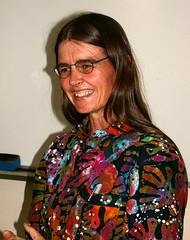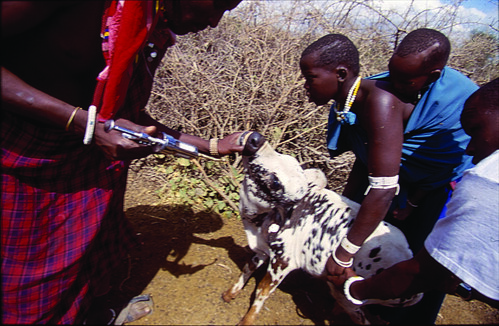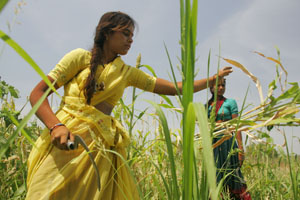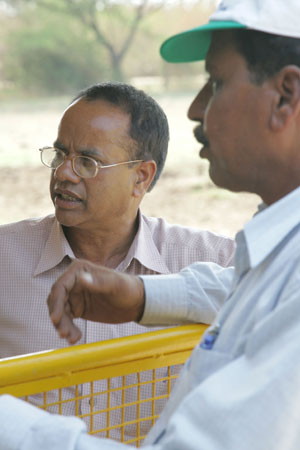Influential PNAS chooses ILRI and partner research on 'linking knowledge with action' for its latest issue (31 March 2009).
 Institutionalization of systems approaches and scaling out of project results arguably remain our greatest challenges in more successfully linking knowledge with action resulting in sustainable poverty reduction.
Institutionalization of systems approaches and scaling out of project results arguably remain our greatest challenges in more successfully linking knowledge with action resulting in sustainable poverty reduction.
Is that true? A new paper published by Patti Kristjanson and colleagues at the International Livestock Research Institute (ILRI) in the prestigious Proceedings of the National Academy of Sciences in the US, thinks it is and argues for seven principles that might help us institutionalize and scale out what works best.
Researchers have traditionally focused on research outputs–articles, methods, technologies, trainings–rather than research outcomes. But it is by jointly defining with project partners the desired outcomes of a project–including changed behaviors, policies, and practices–that links between knowledge and action can be discerned and strengthened.
A group of 19 ILRI and partner researchers have analyzed a broad range of projects using a framework that discloses some helpful lessons. The synthesis of results published in PNAS is entitled ‘Linking International Agricultural Research Knowledge with Action for Sustainable Development’.
Patti Kristjanson, lead author of the paper, says, ‘This article describes ideas, principles and approaches I wish I had been exposed to when I began leading research teams tackling agricultural development and poverty issues across Africa 20 years ago’.
The researchers applied an innovation framework to sustainable livestock development research projects in Africa and Asia. The focus of these projects included pastoral systems, poverty and ecosystems services mapping, market access by the poor, fodder and natural resource management, and livestock parasite drug resistance. The framework arose from a series of propositions advanced at a workshop organized by the Roundtable on Science and Technology for Sustainability of the US National Academies, led by Bill Clark who directs Harvard University’s Sustainability Science Program.
So what helps to close gaps between knowledge and action? What helps take research knowledge beyond the realm of ‘knowledge for knowledge sake’ and convert it to changes in behaviour, practices, policies, institutions and uptake of new technologies?
“The framework is important because it is pragmatic and results oriented. In applying this framework we found that strategies key to closing gaps between knowledge and action include: combining different kinds of knowledge, learning and bridging approaches, strong and diverse partnerships that level the playing field, and building capacity to innovate and communicate” said Bill Clark, Harvey Brooks Professor of International Science, Public Policy and Human Development at Harvard’s Kennedy School of Government.
In examining what approaches, processes, tools and methods helped this very diverse range of project teams be successful in linking knowledge with action, the researchers found that 7 broad principles apply.
|
How to ensure success or failure of getting your research into use
-
Problem definition.
DO: Define the problem to be solved in a collaborative and user-driven manner.
HOW TO FAIL?: Separate yourselves (scientists who produce knowledge) from the decision-makers who use it.
-
Program management.
DO: Adopt a project orientation and organization and appoint dynamic leaders accountable for achieving user-driven goals.
HOW TO FAIL?: Let your ‘study of the problem’ displace ‘creation of solutions’.
-
Boundary spanning.
DO: Use ‘boundary-spanning’ organizations, individuals and actions to help bridge gaps between research and research-user communities, construct informal arenas that foster producer-user dialogues, develop joint ‘rules of engagement’ and define products jointly.
HOW TO FAIL?: Allow dominance by groups committed to the status quo.
-
Systems integration.
DO: Recognize that scientific research is just one ‘piece of the puzzle’ and apply systems-oriented strategies.
HOW TO FAIL?: Don’t engage partners best positioned to help transform knowledge into useful strategies, policies, interventions or technologies.
-
Learning orientation.
DO: Design your project as much for learning as for knowing and to be frankly experimental, expect and embrace failures to learn from them throughout the project’s life.
HOW TO FAIL?: Punish or fail to fund or reward risk-taking managers
-
Continuity with flexibility.
DO: Strengthen links between organizations and individuals operating locally, building strong networks and innovation/response capacity.
HOW TO FAIL?: Leave development of communication strategies and products to the communication experts to do and development of research products for the researchers to do.
-
Manage asymmetries of power.
DO: Level the playing field by generating hybrid, co-created knowledge.
HOW TO FAIL?: Don’t deal with the often large (and largely hidden) asymmetries of power felt by stakeholders.
|
Boundary spanning
Boundary-spanning work takes place between two or more groups that work to different standards and objectives (e.g. basic scientists evaluated by peers versus action people who are validated by political processes). Boundary objects are joint creations at the interface of communities (e.g. models, maps, assessments, contracts, posters). Even more important than ‘boundary-spanning organizations’ are boundary-spanning individuals and efforts. Having said that, individuals work within institutional frameworks, and these need to be supportive of such work (or at the very least, not block it). We need to better understand what kinds of institutional change, if any, encourage or accelerate boundary work. As boundary-spanning activities, behaviors and approaches can be learned, developing courses and training materials in this area may profit research for development. These are environments where partners come together to solve problems and create joint outputs and reach agreement as to new rules of engagement that encourage and support creativity and innovation.
Tools and processes for boundary spanning. Examples of tools and processes that can help span boundaries efficiently and effectively via collaborative efforts include: outcome mapping (<http://www.outcomemapping.ca>), participatory impact pathway analysis (Douthwaite et al, 2003), farmer impact assessment workshops (Kristjanson et al, 2002), challenge dialogue process (<http://www.innovationexpedition.com>), policy evaluation framework (Cohan et al, 1994), adaptive management (www.adaptivemanagement.net), policy-focused assessment process (Schegara and Furrow 2001), joint fact-finding (<http://www.beyondintractability.org/>), value of information approach (Yokota and Thompson, 2004), institutional histories (<http://www.ciat.cgiar.org/riiweb/>), negotiation support (van Noordwijk et al, 2001), and appreciative inquiry (<http://www.cgiar-ilac.org>). ILRI’s community facilitator-researcher approach is another useful model (Nkedianye et al, 2008).
Systems integration
One way to produce both international public goods (those with significance across borders) and local poverty impacts is for research projects to engage local partners in multiple strategically selected sites to ensure the knowledge generated can be extrapolated more broadly. Does mission-oriented research always require a systems approach (e.g. involving public- and private-sectors, non-governmental organizations, community members, scientists, and policymakers)? All our case studies suggest the answer is yes.
There is certainly a role in sustainability science for both traditional, curiosity-driven research as well as for context-specific problem solving-so long as both are conducted within a larger framework that ensures rigor and usefulness. Many scientists fear that their adopting a systems approach will reduce their comparative advantage (e.g., in-depth knowledge of a disciplinary field) and lead to their spending all their time on partnership building and other processes. This risk is real. Our case studies all point to the need to use rigorous processes, ‘tried and tested’ tools, and world-class expertise in facilitating stakeholder engagement, building teams, and establishing ways to measure and communicate impacts and outcomes.
Learning orientation
All organizations interested in transforming themselves (or their self-perceptions) from knowledge producers to knowledge learners face challenges in doing so. Management must support a learning culture and provide incentives for adopting learning approaches, as it has at ILRI, where research performance criteria now include collaborative partnerships and communication outputs beyond scientific journal articles. But ILRI and other institutions ambitious to transform themselves into learning cultures need to go further in supporting and rewarding failures (as often encouraged in private sector research). Initiatives are needed to fund collaborative teams experimenting with different learning approaches to find those that help them link knowledge with action. A cultural and institutional environment that discourages risk taking and finds failures generally unacceptable adds considerably to the challenge of taking a learning-based approach. Convening the right team and committing to co-learning and co-producing ‘hybrid’ knowledge (e.g. a combination of indigenous and scientific knowledge) for action at the beginning of the project is absolutely critical to success. ILRI’s pastoral project is a good example of how institutional ‘protection’ is needed to truly encourage innovative and risk-taking behavior; ILRI management and large external financial support effectively provided a safe space in the sense that the team was protected from external criticism concerning a livestock institute working on wildlife conservation issues.
The issue of improving incentives and rewards for individuals that are successful ‘boundary spanners’ arose in all the case studies. A critical challenge to institutionalizing boundary spanning functions within an organization is to do so while maintaining flexibility to adjust and organize according to constantly changing needs for specific information products. Many institutions are not eager to invest in boundary functions (e.g. workshops, forums, reports) that are perceived to be not a core part of their mission, nor do government or private funders want to invest in the creation of freestanding boundary organizations. We also saw ‘informal communities’ of actors who play no explicit role in the system-often making one-on-one connections between explicit actors who otherwise might not meet-creating key relationships. Because of their ‘stealth’ nature, these are very difficult to identify, yet can be important for successful boundary-spanning, and the links from knowledge to action, to occur.
Conclusion
We believe that projects aiming to improve livelihoods in sustainable ways will increase their likelihood of being successful if they incorporate most if not all of these seven propositions. The working paper explores some of the tools, processes, approaches and strategies that can help research teams apply these principles.
The good news is that these ILRI-partner results indicate that boundary-spanning work is most effective when it is regularized yet flexible and when it enlists the support of informal communities of actors. More research is needed on what kinds of institutional change are likely to encourage and accelerate boundary work, what kind of incentives are needed to encourage individuals to pursue such work, and what kinds of courses and training materials will build capacity in this area.
References
Cohan D, Stafford RK, Scheraga JD, Herrod S (1994) The Global Climate Policy Evaluation Framework. Air and Waste Management Association: Pittsburg, PA. <http://sedac.ciesin.org/mva/iamcc.tg/articles/DC1994/DC1994.html>
Douthwaite B, Kuby T, van de Fliert E, Schulz S (2003) Impact Pathway Evaluation: An approach for achieving and attributing impact in complex systems. Agricultural Systems 78: 243-265.
Kristjanson P et al. (2008) Linking international agricultural research knowledge with action for sustainable poverty alleviation: What works? Joint Center for International Development and International Livestock Research Institute Working Paper, CID Faculty Working Paper 08-173 (Cambridge: Harvard University CID and ILRI) <http://www.cid.harvard.edu/cidwp>
Kristjanson P, Place F, Franzel S, Thornton P (2002) Assessing research impact on poverty: The importance of farmers’ perspectives. Agricultural Systems 72:73-92.
Nkedianye D et al. (2008) Linking knowledge with action and alleviating poverty sustainably using researcher-community-facilitators to span boundaries: Lessons from the Maasai in East Africa. Joint Center for International Development and International Livestock Research Institute Working Paper, CID Faculty Working Paper 08-174 (Cambridge: Harvard University CID and ILRI). <http://www.cid.harvard.edu/cidwp/ >
Schegara J D, Furlow J (2001) From Assessment to Policy: Lessons Learned from the U.S. National Assessment. Human and Ecological Risk Assessment, 7(5):1227-1246.
van Noordwijk M, Tomich T, Verbist B (2001) Negotiation support models for integrated natural resource management in tropical forest margins. Conservation Ecology 5(2):21. <http://www.consecol.org/vol5/iss2/art21/>
Yokota F, Thompson K (2004) Value of information literature analysis: A review of applications in health risk management. Medical Decision Making, Vol.24, No.3:187-298.









 A
A 






 Dr Iain A Wright
Dr Iain A Wright